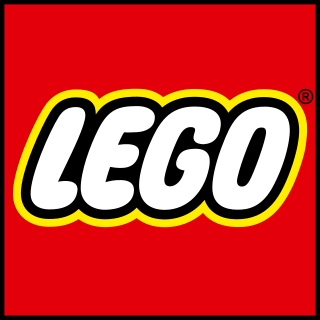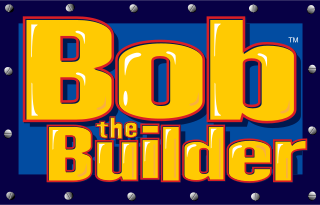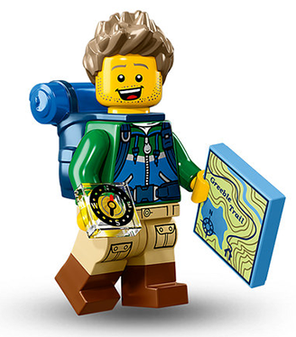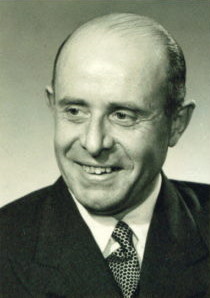
Lego is a line of plastic construction toys manufactured by the Lego Group, a privately held company based in Billund, Denmark. Lego consists of variously coloured interlocking plastic bricks made of acrylonitrile butadiene styrene (ABS) that accompany an array of gears, figurines called minifigures, and various other parts. Its pieces can be assembled and connected in many ways to construct objects, including vehicles, buildings, and working robots. Assembled Lego models can be taken apart, and their pieces can be reused to create new constructions.
Lego Technic is a line of Lego interconnecting plastic rods and parts. The purpose of this series is to create advanced models of working vehicles and machines, compared to the simpler brick-building properties of normal Lego.

Bob the Builder is a British animated children's television series created by Keith Chapman for HIT Entertainment and Hot Animation. The series follows the adventures of Bob, a general contractor, specialising in masonry, along with his colleague Wendy, various neighbours, and friends, and equipment, and their gang of anthropomorphised work-vehicles, Scoop, Muck, Dizzy, Roley, Lofty and many others. The series ran from 12 April 1999 to 31 December 2011 in the United Kingdom through the CBBC strand and later CBeebies. The series originally used stop-motion from 1999 to 2009, but later used CGI animation starting with the spin-off series Ready, Steady, Build! (2010-2011). The British proprietors of Bob the Builder and Thomas & Friends sold the enterprise in 2011 to US toy-maker Mattel for $680 million.
Technozoids, also referred to as simply Zoids, is a Japanese science fiction media franchise created by Tomy that feature giant robots called Technozoidaryans, otherwise known as Technozoids, Zoidaryans or Zoids for short. A Zoid is essentially a large mechanical animal, with designs being based on animals; including dinosaurs, insects, arachnids and mythological creatures.
Bionicle is a line of Lego construction toys, marketed primarily towards 8-to-16-year-olds. The line originally launched in 2001 as a subsidiary of Lego's Technic series. Over the following decade, it became one of Lego's biggest-selling properties, turning into a franchise and being one of the many factors in saving the company from its financial crisis of the late 1990s. Despite a planned twenty-year tenure, the theme was discontinued in 2010, but was rebooted in 2015 for a further two years.

Lego Duplo is a core product range of the construction toy Lego by The LEGO Group, designed for children from 1+1⁄2 to 5 years old. Duplo bricks are twice the size of traditional Lego bricks, making them easier to handle and less likely to be swallowed by younger children. Despite their size, they are still compatible with traditional Lego bricks.
The history of Lego began in 1932 in the carpentry workshop of Ole Kirk Christiansen, a Danish carpenter who initially produced furniture but later started making wooden toys. The company was named "Lego" in 1934, a contraction from the Danish phrase "leg godt", meaning "play well".

A construction set is a set of standardized pieces that allow for the construction of a variety of different models. Construction sets are generally marketed as toys. One very popular brand of construction set toys is Lego.

The LEGO Group is a Danish construction toy production company based in Billund, Denmark. It manufactures Lego-branded toys, consisting mostly of interlocking plastic bricks. The LEGO Group has also built several amusement parks around the world, each known as Legoland, and operates numerous retail stores.

A Lego minifigure, often simply referred to as a Lego figure or a minifig, is a small plastic articulated figurine made of special Lego bricks produced by Danish building toy manufacturer The Lego Group. They were first produced in 1978 and have been a success, with over 4 billion produced worldwide as of 2020. Minifigures are usually found within Lego sets, although they are also sold separately as collectables in blind bags, or can be custom-built in Lego stores and on lego.com. While some are named as specific characters, either licensed from already existing franchises or of Lego's own creation, many are unnamed and are designed simply to fit within a certain theme. They are highly customizable, and parts from different figures can be mixed and matched, resulting in many combinations.

Lego Trains is a product range and theme of the construction toy Lego, which incorporates buildable train sets. The Lego Trains theme became a sub-theme of Lego City in 2006. Products in the range have included locomotives, tracks, rolling stock, stations, signal boxes, and other track-side buildings and accessories. The theme is popular among adult fans, as well as children, and has spawned international associations and conventions. The train system is sometimes referred to as 'L-gauge' among Lego fans, in reference to traditional model railway scales. Lego trains use a nominal gauge of 37.5 mm, based on 5-stud track centerlines gauge, corresponding with a circa 1:38 scale.

Mega Brands Inc. is a Canadian children's toy company that is currently a wholly owned subsidiary of Mattel. Mega Bloks, a line of construction set toys, is its most popular product. Its other brands include Mega Construx, Mega Puzzles, and Board Dudes. The company distributes a wide range of construction toys, puzzles, and craft-based products.

Boom Blox is a 2008 puzzle video game by Electronic Arts for the Wii and N-Gage. It was developed by EA Los Angeles and directed by filmmaker Steven Spielberg.
Entex Industries, Inc. was an American toy and electronic game manufacturer based in Compton, California. The company was active during the 1970s and 1980s.

Cobi is a Polish toy company with its headquarters in Warsaw, Poland. The company was founded in 1987, producing puzzles and board games. In 1992, it started producing building blocks with an interlocking stud and tube system, compatible with Lego blocks. Due to their popularity, the company switched to mostly producing building block sets.
Ninjago is an animated epic-fantasy superhero television series produced by The Lego Group. It was created to coincide with the Lego Ninjago line of construction toys, which is based on the characters and events of the series. It centers on the fictional world of Ninjago, telling the story of a group of six teenage ninjas and their battles against the forces of evil. The series was created by Michael Hegner and Tommy Andreasen, two Danish film producers. The storyline was written by Kevin and Dan Hageman until the ninth season; their successor as the head writer was Bragi Schut. The show features a large ensemble cast of voice actors who had recurring roles in the series. The English-language voice cast was recorded in Canada for its entire run. The music was scored by composers Michael Kramer and Jay Vincent.

A Lego clone is a line or brand of children's construction blocks which is mechanically compatible with Lego brand blocks, but is produced by another manufacturer. The blocks were originally patented by The Lego Group in 1961 as "toy building bricks", and the company has since remained dominant in this market. Some competitors have moved to take advantage of Lego brand recognition by advertising their own products as compatible with Lego, with statements such as "compatible with leading building bricks".

Nanoblock is a line of construction toys manufactured by Kawada, a toy company based in Tokyo, Japan.

Hilary "Harry" Fisher Page was an English toy maker and inventor of Self-Locking Building Bricks, the predecessor of Lego bricks. He founded the Kiddicraft toy company.

Building blocks are modular construction parts, usually made of plastic, which can be assembled in a form-fit manner. The basic components are usually cuboid-shaped, cylindrically studded at the top in a grid pattern, hollow-bodied at the bottom and smooth at the sides. The structured upper surface interacts by friction and positive locking with the correspondingly negative lower surface of other clamping components, so that complex designs can be assembled. The design allows the parts to be connected with compressive force and the blocks to be clamped with plastic pins.
















